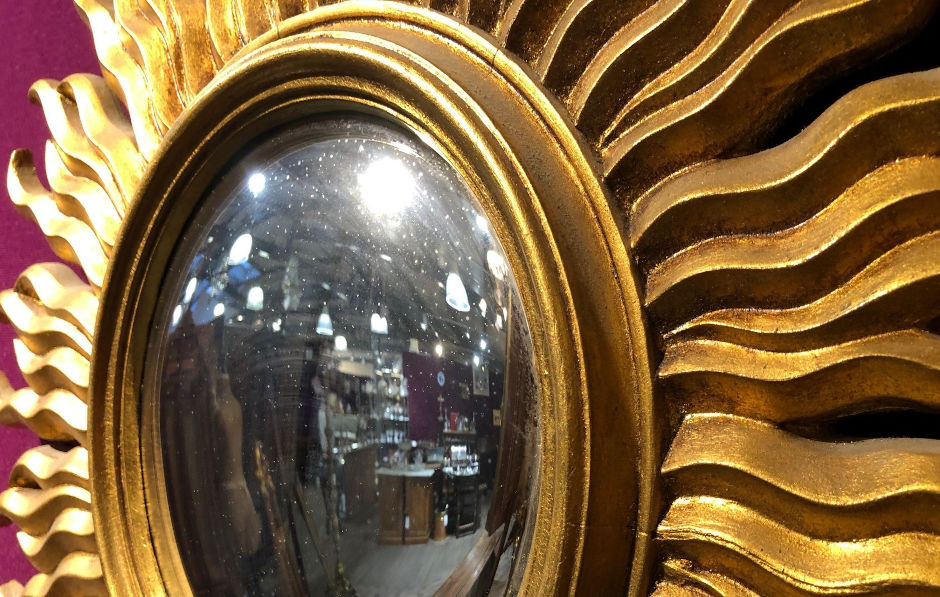
The word mirror comes from the French ‘mirer’, which in turn derives from the Latin ‘mirari’, to admire or marvel. From the evil Queen’s enchanted mirror in the Grimm Brothers’ ‘Snow White’ to Lewis Carroll’s ‘Through the Looking Glass’, we have always been fascinated by mirrors, and the market for antique pieces can offer rich pickings for those who know what to look for.
The earliest ‘mirrors’ would have been a highly polished piece of metal such as copper or tin, or pieces of convex shaped glass. It wasn’t until the 15th and 16th centuries that world famous glass makers in Murano, Italy developed the modern method of mirror making. The method developed by the Venetian glassmakers is still used today and involves the application of a silver backing to a flat piece of glass.
There are many styles of antique mirror that are highly collectable, from Rococo mirrors in the early 18th century (characterised by heavy and complex frames, often adorned with plaster sculptures of shells and leaves, and heavily gilded) to the heavily carved and rather grand Victorian mirrors, often crafted from mahogany or rosewood.
Whether you are a collector of antique mirrors or are just looking for an addition to your home, or a gift for someone special, our dealers at Hemswell offer a wide selection of antique mirrors. If you’re not sure of the type of mirror you might be looking for, our list of the most popular will help you narrow down the choice.
- Floor standing or cheval mirrors – a floor standing mirror will stand alone on the ground, allowing a large area to be viewed through it at once. This is the ideal choice of mirror for a largely proportioned room where you want to introduce light or a greater sense of space. A cheval mirror is usually oval or rectangular in shape and is supported on legs. These are a popular choice for dressing rooms and bedrooms, as you can view your entire self at once.
- Hand mirror – hand held mirror and brush sets were popular with Victorian ladies and were often set within a silver mounting. By contrast, the hand-held mirrors of the same time in Germany and France often featured hand-painted porcelain backs.
- Dressing table mirror – these are sometimes referred to as toilet mirrors and were designed to add a decorative element to a table. As they evolved, small drawers were introduced into their bases and are a precursor to the vanity mirror favoured by Victorian ladies to display perfumes and accessories.
- Wall mirror – as the name suggests, these are mirrors specifically designed to hang on a wall. Today, wall mirrors come in all shapes and sizes but antique examples, which are often large and decorative, came about in the late 18th century.
Once you have decided on the mirror you want, there are things to look for before making your purchase, as today’s reproductions can have the shape and style of their antique counterparts.
- Check the glass, looking for any damage including oxidation, scratches, cracks or chips.
- Modern glass that has been produced with modern manufacturing techniques, will be smooth and free of bubbling. Look closely for signs of bubbling and although such an imperfection is not a guarantee of age, if a mirror looks too perfect, it is unlikely to be antique.
- Very early mirrors were backed with mercury coated tin. These mirrors age to form a sparkly effect so a mirror with a crystalline appearance behind the glass is likely to be antique.
- When the backing of a mirror tarnishes with time, dark patches can become visible when looking through the front of the mirror, and are often concentrated towards the bottom. Be aware however, that uniform patching is unlikely to occur naturally and may be a sign that the mirror has been artificially aged.
- Examine the frame closely. An antique frame will show signs of age, possibly in the form of chips or wearing on any carved detailing. It may also have discolouration and even dust in deeply carved features.
- A new mirror may have been housed in an antique frame, so check the reverse of the mirror. Are there modern screws present? If so, this may indicate that the mirror could be modern.
Buying an antique mirror from Hemswell Antique Centres will give you the peace of mind that your item will be the genuine article; our dealers will have used their experience and extensive knowledge to ensure your item is not a reproduction and will be able to advise on whether a piece has previously been repaired or altered. You can also browse our extensive range of antique mirrors online, and be confident that our expertise means that your fragile piece can be delivered safely to a destination of your choice.